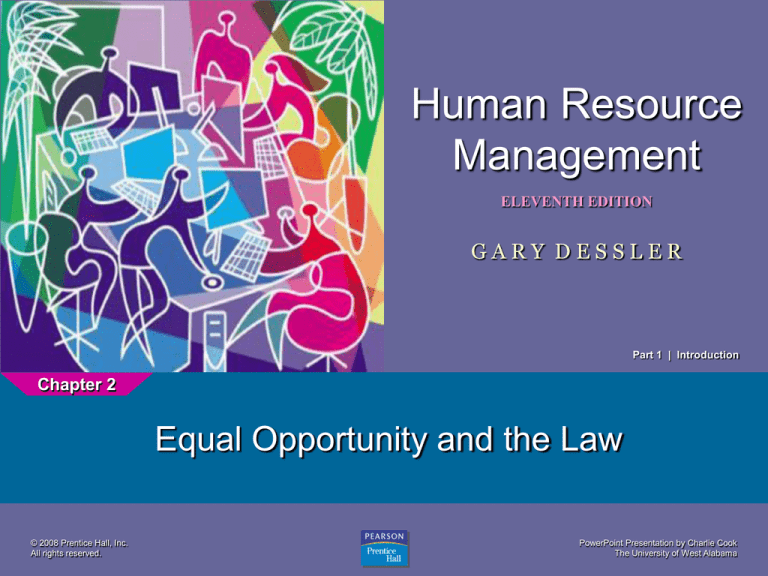
Human Resource
Management
1
ELEVENTH EDITION
GARY DESSLER
Part 1 | Introduction
Chapter 2
Equal Opportunity and the Law
© 2008 Prentice Hall, Inc.
All rights reserved.
PowerPoint Presentation by Charlie Cook
The University of West Alabama
After studying this chapter, you should be able to:
1. Cite the main features of at least five employment
discrimination laws.
2. Define adverse impact and explain how it is proved
and what its significance is.
3. Explain and illustrate two defenses you can use in the
event of discriminatory practice allegations.
4. Avoid employment discrimination problems.
5. Cite specific discriminatory personnel management
practices in recruitment, selection, promotion, transfer,
layoffs, and benefits.
6. Define and discuss diversity management.
© 2008 Prentice Hall, Inc. All rights reserved.
2–2
Early Court Decisions Regarding
Equal Employment Opportunity (cont’d)
• Albemarle Paper Company v. Moody
If a test is used to screen candidates, then the job’s
specific duties and responsibilities must be analyzed
and documented.
The performance standards for the job should be
clear and unambiguous.
Federal guidelines on validation are to be used for
validating employment practices.
© 2008 Prentice Hall, Inc. All rights reserved.
2–3
Employer Obligations Under ADA
•
An employer must make a reasonable accommodation for
a qualified disabled individual unless doing so would result
in undue hardship.
•
Employers are not required to lower existing performance
standards or stop using tests for a job.
•
Employers may ask pre-employment questions about essential
job functions but can not make inquiries about disability.
•
Medical exams (or testing) for current employees must be
job-related.
•
Employers should review job application forms, interview
procedures, and job descriptions for illegal questions and
statements.
•
Employers should have up-to-date job descriptions that identify
the current essential functions of the job.
© 2008 Prentice Hall, Inc. All rights reserved.
2–4
Disabilities and ADA
• Courts will tend to define “disabilities” quite narrowly.
• Employers are not required to tolerate misconduct
or erratic performance, even if the behaviors can be
attributed to the disability.
• Employers do not have to create a new job for the
disabled worker nor reassign that person to a light-duty
position for an indefinite period, unless such a position
exists.
• Employers should not treat employees as if they are
disabled so that they will not be “regarded as” disabled
and protected under the ADA.
© 2008 Prentice Hall, Inc. All rights reserved.
2–5
State and Local Equal Employment
Opportunity Laws
• State and Local Laws
Cannot conflict with federal law but can extend
coverage to additional protected groups.
The EEOC can defer a discrimination charge to state
and local agencies that have comparable jurisdiction.
© 2008 Prentice Hall, Inc. All rights reserved.
2–6
Other Considerations in Discriminatory
Practice Defenses
1. Good intentions are no excuse.
2. Employers cannot hide behind collective
bargaining agreements—equal opportunity
laws override union contract agreements.
3. Firms should react by agreeing to eliminate an
illegal practice and (when required) by
compensating the people discriminated
against.
© 2008 Prentice Hall, Inc. All rights reserved.
2–7
Mandatory Arbitration
• Gilmer v. Interstate/Johnson Lane Corp.
Employers can compel employees to agree
to mandatory arbitration of employment-related
disputes.
• Recommendations
Request party be compelled to arbitrate claim.
Insert arbitration clause in employment applications
and employee handbooks.
Protect arbitration process from appeal.
• Alternative Dispute Resolution (ADR)
© 2008 Prentice Hall, Inc. All rights reserved.
2–8
Diversity Management Program
Steps in a Diversity Management Program:
1
Provide strong leadership
2
Assess the situation
3
Provide diversity training and education
4
Change culture and management systems
5
Evaluate the diversity management program
© 2008 Prentice Hall, Inc. All rights reserved.
2–9
Designing an Affirmative Action Program
• Good Faith Effort Strategy
Eliminating the present effects of past practices
that excluded or underutilized protected groups.
Identification through numerical analysis.
Proactive elimination of employment barriers.
Increased minority or female applicant flow.
• Increasing Employee Support for
Affirmative Action
Transparent selection procedures
Communication
Justifications
© 2008 Prentice Hall, Inc. All rights reserved.
2–10
Reverse Discrimination
• Reverse Discrimination
Discrimination against non-minority applicants and
employees by quota-based systems.
Bakke
v. Regents of the University of California
Wygant
U.S.
v. Jackson Board of Education
v. Paradise
Johnson
v. Transportation Agency, Santa Clara
County
© 2008 Prentice Hall, Inc. All rights reserved.
2–11
KEY TERMS
Title VII of the 1964 Civil Rights Act
Equal Employment Opportunity
Commission (EEOC)
affirmative action
Office of Federal Contract Compliance
Programs (OFCCP)
Equal Pay Act of 1963
Age Discrimination in Employment Act
of 1967 (ADEA)
Vocational Rehabilitation Act of 1973
Vietnam Era Veterans’ Readjustment Act
of 1974
Pregnancy Discrimination Act (PDA)
uniform guidelines
sexual harassment
© 2008 Prentice Hall, Inc. All rights reserved.
Federal Violence Against Women Act
of 1994
protected class
Civil Rights Act of 1991 (CRA 1991)
mixed motive case
Americans with Disabilities Act (ADA)
qualified individuals
adverse impact
disparate rejection rates
restricted policy
bona fide occupational qualification (BFOQ)
alternative dispute resolution or ADR
program
good faith effort strategy
reverse discrimination
2–12









